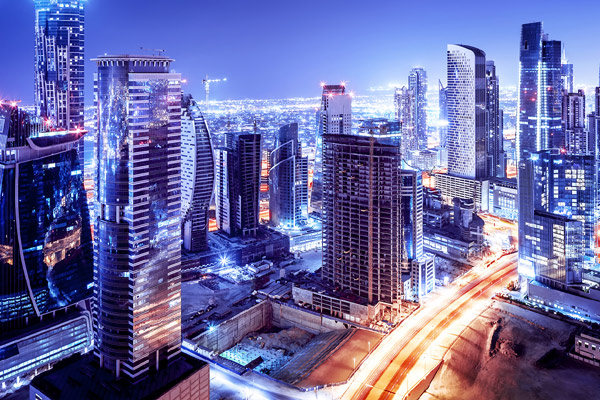Hotels in the Middle East reported negative performance results for 2018, while hotels in Africa posted total-year growth across the three key performance metrics, according to data from STR - a leading market research firm.
Occupancy levels in the Middle East slipped 0.5 per cent to 64.6 per cent, with average daily rate (ADR) dropping 5.2 per cent to $155.45. Revenue per available room (RevPAR) also fell 5.7 per cent to $100.45.
In Doha, Qatar, occupancy rates were recorded at 60.8 per cent in 2018, a 10.1 per cent increase compared to 2017. However, ADR was down 18.8 per cent to QR269.46 ($73.5) and RevPAR also dropped 10.6 per cent to QR163.86 ($44.7).
STR analysts cite tourism recovery which was helped by a shift to alternative source markets and fast-tracked reforms stemming from Qatar’s National Tourism Sector Strategy 2030 as reasons behind a 14.3 per cent jump in demand. The 60.8 per cent absolute occupancy level was still low compared to recent years, but year-over-year growth was pronounced because 2017 was such a low demand year affected by the blockade imposed on the country. ADR, on the other hand, continued to decline in 2018 as hoteliers looked to maintain market share with an influx of new supply entering the country.
Occupancy rates in Africa were up 4.7 per cent to 60.6 per cent, with ADR going up 7.1 per cent to $118.31. RevPAR climbed 12.1 per cent to $71.74.
Among subcontinents in the region, Northern Africa posted the largest 2018 increases in each of the three key performance metrics: occupancy (up 11.8 per cent to 61.1 per cent), ADR (up 13.8 per cent to $96.81) and RevPAR (up 27.2 per cent to $59.18). Within Northern Africa, Egypt, Morocco and Tunisia each recorded double-digit RevPAR growth for the year.
In Cairo and Giza, Egypt, occupancy was up 11 per cent to 72.5 per cent and ADR rose 10.8 per cent to EGP1,713.35 ($95.5). RevPAR moved up a record 23.1 per cent to EGP1,242.20 ($69.2).
According to STR analysts, the submarket’s 10.5 per cent rise in demand (room nights sold) was mostly a result of tourism recovery, improved security protocols, resumed flights with Russia, and marketing campaigns. ADR growth was helped by the combination of increased guest demand and competitive pricing due to the devaluation of the Egyptian Pound. Overall, the absolute occupancy level was the highest for Cairo and Giza since 2008, while the ADR value was the highest STR has ever benchmarked for the submarket. - TradeArabia News Service
Travel, Tourism & Hospitality
ME hotel occupancy, rates down in 2018, Africa results positive

- Similar Stories

Tobias Ernst appointed Director of Operations at Shangri-La Jeddah

Global Health Alliance celebrates ‘power of partnerships’ at Berlin event

Saudi Arabia showcases investment initiatives in tourism at forum

Alstom lands Jeddah Airport's APM system upgrade contract

ATM 2024 to explore impact of entrepreneurship, innovation on travel

Saudi forum to provide a glimpse into future of pilgrimage

Nabni starts work on Waldorf Astoria Residences sales centre

Etihad Airways welcomes 1.4 m passengers in March

Travellers invited to explore Germany’s Unesco Heritage sites

Hamad International Airport named the ‘World’s Best Airport’

Emirates re-starts check-in at Dubai International

Bahrain airport wins top honours at World Airport Awards

Flydubai resumes partial operations from Dubai

Abu Dhabi's Zayed Airport stays fully operational

Queen Alia airport passenger traffic in March declines

IATA and partners release report on aviation net zero roadmaps

Travel Connections Arabia in deal to redefine wellness experience

Hassan Allam unit wins Amaala Triple Bay hotel contract

Boeing buys 35.6m litres of blended sustainable aviation fuel

Asil to host first ‘four hands dinner’ as part of food festival

Flydubai flight operations from Dubai disrupted

Emirates suspends check-in at Dubai International today

Global Hotel Alliance reports stellar Q1 performance in its 20th year

The Royal Mansour Casablanca: rebirth of an iconic address

Choice Hotels in deal to award new ‘frequent flyer’ rewards

Nikki Beach Global is now Nikki Beach Hospitality Group

SHI Group raises the bar for sustainable dining practices

Jumeirah Messilah Beach Hotel’s spa awarded Forbes Travel Guide star rating

Dubai Food Festival to line up gastronomic events and experiences

Ozen Collection appoints woman leader for key role in new Kolkata hotel
